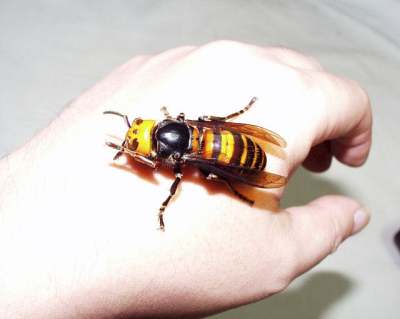I was reading Jerry Coyne's Why evolution is true when I stumbled upon one of the most hilarious paragraphs so far.
But first, a little background info:
Jerry A. Coyne begins the 5th chapter of the book, "The engine of evolution", by talking about Asian giant hornets: mean, huge predatory wasps that are most often found in Japan. They reach about 5 cm in length.
These Japanese hornets (Vespa mandarinia) are natural killers: huge, fierce, strong jaws and a venomous stinger that can easily kill humans. Not only that, but they can even outrun you, should you ever try to "race" them. Unless you can match 40 km/hour (25 miles/hour), that is. They can cover distances of almost 100 kilometers (60 miles) in a single day.
Hornets are predators in the sense that they raid the nests of social bees and other wasps. They are a nuisance for beekeepers, since they also prey upon honey-bees. The problem with honey-bees is that most of them (the ones introduced by Europeans, in any case) are defenseless. Just thirty (30!) hornets are enough to ravage a colony of up to thirty thousand (30,000!) honey-bees.
The giant hornets slaughter the honey-bees and then eat the honey and feed the bee grubs to their own offspring.
The raid strategy used by Vespa mandarinia is to send off a hornet scout in search of bee nests. When it finds one, it marks the entry with special pheromones that the other giant wasps pick up, knowing whose nest to invade.
Such horrifying killing machines.
However weird it may sound, there are certain bees which evolved a striking adaptation. It is only exhibited by native Japanese honey-bees.
I will quote Jerry Coyne. And, yes, here comes the phrase I found so funny, as well (the emphasis is mine):
The hornets are fearsome hunting machines, and the introduced bees are defenseless. But there are bees that can fight off the giant hornet: honeybees that are native to Japan. And their defense is stunning – another marvel of adaptive behavior. When the hornet scout first arrives at their hive, the honeybees near the entrance rush into the hive, calling nestmates to arms while luring the hornet inside. In the meantime, hundreds of worker bees assemble inside the entrance. Once the hornet is inside, it is mobbed and covered by a tight ball of bees. Vibrating their abdomens, the bees quickly raise the temperature inside the ball to about 47 degrees C. Bees can survive this temperature, but the hornet cannot. In twenty minutes the hornet scout is cooked to death, and – usually – the nest is saved. I can't think of another case (save the Spanish Inquisition) in which animals kill their enemies by roasting them.
(Coyne, J. A., 2009, Why evolution is true, page 122, Oxford University Press)
That is an unexpected and welcome remark. The writing style, in fact, is pleasant and humorous in many parts. I mean, how can somebody address creationist and ID claims without poking fun at the silliness of some of the claims?
This is not to say that Why evolution is true only addresses creationist claims; on the contrary, it is a very interesting and captivating read, packed with examples on every page and featuring fine illustrations. The print I have, the 2009 hardcover edition, is a pleasure to read. It is a very appealing book, I might say, from cover to cover.
Long story short, it is a book that I strongly recommend to science enthusiasts and flat-earthers alike. One of those "everybody must read this!" books. I will probably write a more in-depth post after I finish it.
Anyway, here is a video of Japanese honey-bees in action, defending their nest against the giant hornet intruder:
Suggested reading
- The Why evolution is true (Jerry Coyne's) blog
- Coyne, J. A., 2009, Why evolution is true, Oxford University Press
- More on the Asian giant hornet, Vespa mandarinia





No comments:
Post a Comment